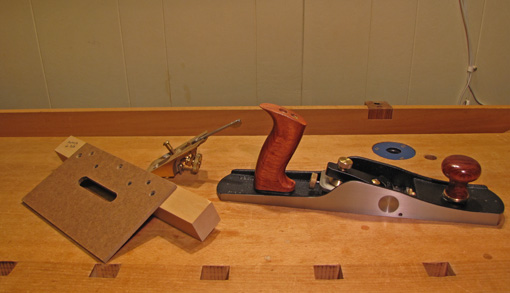Thoughts arising while sweeping the shop floor, waiting for boards to come out the back end of the thickness planer, or putting away tools . . .
A principle known as Occam’s Razor holds that the simplest explanation for a phenomenon is usually the best among reasonable, verifiable, non-simplistic possibilities. In other words, eliminate the burden of the unnecessary. I propose the Woodworker’s Edge: let this principle apply to woodworking jigs. The simplest jig that gets the job done quickly and well is the best jig. The idea is to make woodworking projects, not elaborate jigs. Simple, effective jigs are cool jigs.
I wish someone would manufacture a 12″ jointer with about a 55″ bed. I mean just the jointer, not a jointer-planer combination and not an aircraft carrier monstrosity. I could use it along with my DW735 portable thickness planer. I imagine it would save a large share of the cost of a combination machine, not to mention changeover hassles, while retaining the advantages of the 12″ width.
I wish Lie-Nielsen would make a 55 degree frog for their #4 smoothing plane (2″ blade width) as they do for their #4 ½ (2 3/8″ blade width). 45 and 50 degree frogs are available for both planes. I’ve used the #4 bronze nearly since it was first produced, and later replaced its 45 degree frog when the 50 became available. It is my all-round smoother and I’ve never used the 45 frog since. It seems the 55 would make even more sense for difficult woods in a #4 than in a #4 ½ since the narrower plane would reduce the pushing force required.
Speaking of planes, the rear handles on Veritas bench planes are . . . well, if you use them you know . . . not exactly agreeable to human hands, at least not to mine. I do understand that they are fixed with two bolts instead of the usual one and the straighter profile accommodates this. I have two of their low angle planes and otherwise like them very much. Lee Valley is a wonderful company. But the handles, please, guys, can you do something?
I wish more wood was sawn into different thicknesses within one flitch. That way table legs, aprons, and tops could be made from consistent wood taken from one flitch without having to resaw the dried lumber. I guess this would be a lot of trouble for the sawmill and maybe just too impractical, but it would be nice to have such lumber widely available. Using 8/4 lumber for all the parts of a table requires a lot of resawing. There is always a bit of a gamble, certainly considerable waste, and more work in resawing 8/4 lumber to get 3/4″ finished stock.
I don’t think techniques need to be advertised as they so often are in woodworking publications: “foolproof, super-easy, super-quick, perfect every time,” etc. Woodworking is wonderfully accessible, but it is not that easy, not that quick, nothing works out perfectly every time, and techniques do not need to be foolproof because woodworkers are not fools. I guess the following is less marketable: “Here’s a clear, sensible procedure that works for me, and, after some practice, will give you excellent results as long as you are careful, patient, and use the proper tools.”
I’d buy that.



I completely agree about the different thickness flitches. That would make life so much simpler and easier to plan out your project. You might even say it would be foolproof! :)
Good points, all.
Recently I’ve gotten into the making of many single purpose jigs to manufacture the Super Chute, in fact, there is now a dedicated wall space organized with 17 jigs. There are also new ones for my table saw and drill press. During the process it seemed a little agonizing to reach the point so often in fabrication where I realized another jig was required for accuracy and repeatability (“oh no, another jig?”) because you just want to build your project and not stop to do something else. Some of them have been redesigned and rebuilt, as has the featured product itself. In the end, I think the stimulating problem solving and experimentation involved in jig making are complimentary to building furniture. Design, create, and evaluate. It’s a very rewarding process.
Woodworking is wonderfully accessible, but it is not that easy…
That sums up my experience perfectly. Even though wood is dead it acts like it’s alive and has a mind of its own.
You can make a 55 degree plane with your veritas low angle (sorry about the handle). Sharpen a blade at a steeper angle until the bed and blade angle equal what you want (Caveat – I use the LN low angle jack but haven’t tried this yet – just read about it. People that have tried it say it works.)
With your skill I wonder why you don’t make your own smoother with a 55 degree bed. Krenov planes are easy and work well. You can make one as wide or narrow and a whatever pitch you want.
Shannon,
If you know of sawyers/dealers that make this available on a regular basis, I and readers would appreciate it. I don’ t know of any.
Tico,
Good luck with the shooting board. Readers, click on Tico’s name and check it out.
John,
Yes, as it happens, that is part of the next post. I don’t know why I don’t make Krenov planes. I think I should.
Rob
Hi,
At the LN hand tool event last week, their rep announced that they would be producing the 55° frog for the #4.
Thanks, Steve. Just last week? Hey, ya don’t suppose . . . naaah, just a passing thought.
Rob